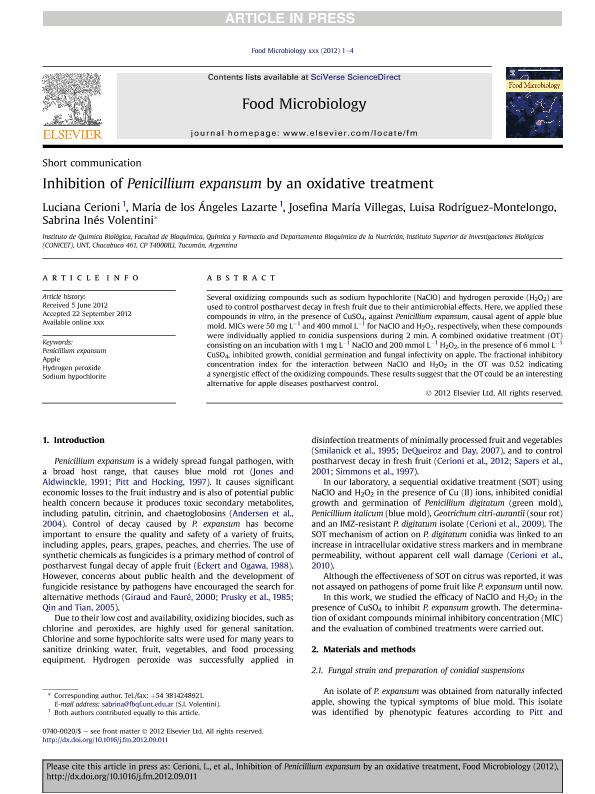Artículo
Inhibition of Penicillium expansum by an oxidative treatment
Cerioni, Luciana ; Lazarte, María de Los Ángeles; Villegas, Josefina Maria
; Lazarte, María de Los Ángeles; Villegas, Josefina Maria ; Rodríguez Montelongo, Luisa; Volentini, Sabrina Inès
; Rodríguez Montelongo, Luisa; Volentini, Sabrina Inès
 ; Lazarte, María de Los Ángeles; Villegas, Josefina Maria
; Lazarte, María de Los Ángeles; Villegas, Josefina Maria ; Rodríguez Montelongo, Luisa; Volentini, Sabrina Inès
; Rodríguez Montelongo, Luisa; Volentini, Sabrina Inès
Fecha de publicación:
04/2013
Editorial:
Academic Press Ltd - Elsevier Science Ltd
Revista:
Food Microbiology
ISSN:
0740-0020
Idioma:
Inglés
Tipo de recurso:
Artículo publicado
Clasificación temática:
Resumen
Several oxidizing compounds such as sodium hypochlorite (NaClO) and hydrogen peroxide (H2O2) are used to control postharvest decay in fresh fruit due to their antimicrobial effects. Here, we applied these compounds in vitro, in the presence of CuSO4, against Penicillium expansum, causal agent of apple blue mold. MICs were 50 mg L-1 and 400 mmol L-1 for NaClO and H2O2, respectively, when these compounds were individually applied to conidia suspensions during 2 min. A combined oxidative treatment (OT) consisting on an incubation with 1 mg L-1 NaClO and 200 mmol L-1 H2O2, in the presence of 6 mmol L-1 CuSO4, inhibited growth, conidial germination and fungal infectivity on apple. The fractional inhibitory concentration index for the interaction between NaClO and H2O2 in the OT was 0.52 indicating a synergistic effect of the oxidizing compounds. These results suggest that the OT could be an interesting alternative for apple diseases postharvest control.
Palabras clave:
APPLE
,
HYDROGEN PEROXIDE
,
PENICILLIUM EXPANSUM
,
SODIUM HYPOCHLORITE
Archivos asociados
Licencia
Identificadores
Colecciones
Articulos(CCT - NOA SUR)
Articulos de CTRO.CIENTIFICO TECNOL.CONICET - NOA SUR
Articulos de CTRO.CIENTIFICO TECNOL.CONICET - NOA SUR
Articulos(CERELA)
Articulos de CENTRO DE REFERENCIA PARA LACTOBACILOS (I)
Articulos de CENTRO DE REFERENCIA PARA LACTOBACILOS (I)
Articulos(INSIBIO)
Articulos de INST.SUP.DE INVEST.BIOLOGICAS
Articulos de INST.SUP.DE INVEST.BIOLOGICAS
Citación
Cerioni, Luciana; Lazarte, María de Los Ángeles; Villegas, Josefina Maria; Rodríguez Montelongo, Luisa; Volentini, Sabrina Inès; Inhibition of Penicillium expansum by an oxidative treatment; Academic Press Ltd - Elsevier Science Ltd; Food Microbiology; 33; 2; 4-2013; 298-301
Compartir
Altmétricas



